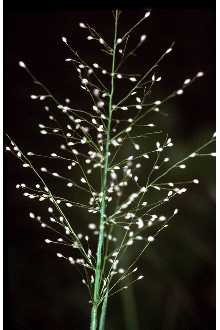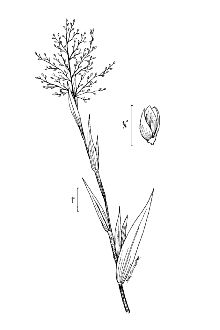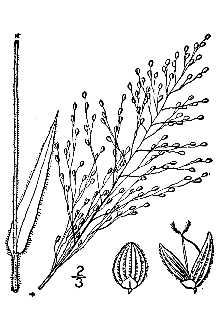Velvet Panicum
Scientific Name: Dichanthelium scoparium (Lam.) Gould

| General Information | |
|---|---|
| Usda Symbol | DISC3 |
| Group | Monocot |
| Life Cycle | Perennial |
| Growth Habits | Graminoid |
| Native Locations | DISC3 |
Plant Guide
Alternative Names
Velvet rosettegrass and broom panic-grass
Uses
Wildlife Value: Because of their wide distribution, Dichanthelium spp. provides an important source of food for songbirds, small mammals and game birds (Miller, 1999). Erosion Control: This species has a high tolerance of low pH conditions and is suitable for erosion control along roadsides and timber harvest areas.
Status
Please consult the PLANTS Web site and your State Department of Natural Resources for this plant’s current status (e.g. threatened or endangered species, state noxious status, and wetland indicator value).
Description
General: Grass Family (Poaceae). To date, there are 26 identified species of Dichanthelium spp. in the southeastern United States (Miller, 1999). This species is distinguished from other North American grasses by its unique growth pattern. A basal rosette is produced during fall and winter with stems developing in the spring (Gould, 1978). Velvet panicum is a native perennial bunchgrass. However, the plant’s lifespan is considered to be short when compared to other perennial plants. It has erect coarse stems up to 4.5 feet tall. The gray-green stems and leaves are covered with fine hairs. The leaves are .25 to 1.0 inch wide which are smaller than broadleaf rosettegrass (D. latifolium) and Bosc’s panicgrass (D. boscii) (USDA-NRCS, 2007 and Grelen, 1984). The plant produces seed in the summer (May to June) and also in the fall. The fall seeds are found within the spikelet sheath. Velvet panicum is considered a C3 (cool season) photosynthetic pathway plant (Gould, 1978). Velvet panicum is a diploid (2n = 18). The plant tends to flower later than the other Dichanthelium species if they are present in a stand (Gould, 1978). There are approximately 380,000 seeds per pound; however, velvet panicum is considered a low volume seed producer (USDA-NRCS, 2007).
Distribution
For current distribution, please consult the Plant Profile page for this species on the PLANTS Web site. Adaptation: Velvet panicum is adapted to the eastern United States from New York to Florida west to Kansas and Texas. This adaptation area corresponds to USDA Hardiness Zones 5b to 10b. Velvet panicum grows in areas with precipitation ranging from 30 to 55 inches. It prefers coarse and medium textured soils with pH range of 4.5 to 7.5. Velvet panicum is not tolerant of salinity (USDA-NRCS, 2007). This plant is found in sandy woods, bogs, marshes, and disturbed sites. It is often found scattered throughout new forest plantations (Miller, 1999). Velvet panicum is seldom found on burned or grazed forest range (Grelen, 1984).
Establishment
Fertilize planting area according to soil test for establishment, Maintain fertility levels at medium conditions and soil pH near 6, Use soil moisture sensors to measure the soil moisture of Velvet Panicum.,0, To reduce weed competition, do not over apply nitrogen fertilizer, Cold stratification is not required in preparation for planting (USDA-NRCS, 2007), Plant the seed at a rate of 3,0 pure live seed pounds per acre in the fall when the ground is moist, Drill or hand plant seeds at a depth of ½” or less, If broadcasting, use a cultipacker to increase seed to soil contact,
Management
If managing as a planting: Do not over apply nitrogen fertilizer or keep soil fertility at a high level. Seed production maybe decreased by high fertility levels. Please contact your local agricultural extension specialist or county weed specialist to learn what works best in your area and how to use it safely. Always read label and safety instructions for each control method. Trade names and control measures appear in this document only to provide specific information. USDA NRCS does not guarantee or warranty the products and control methods named, and other products may be equally effective.
Pests and Potential Problems
Seed production: Velvet panicum will hybridize with tapered rosettegrass (D. acuminatum) and cypress panicgrass (D. dichotomum) (Diggs, 2006).
Environmental Concerns
Concerns
Concerns
This plant is considered an endangered species in Indiana. Please consult the PLANTS Web site and your State Department of Natural Resources for this plant’s current status (e.g. threatened or endangered species, state noxious status, and wetland indicator values).
Seeds and Plant Production
Plant Production
Plant Production
When managing for seed production, mow in the spring to clip off previous year’s growth. At the East Texas Plant Materials Center, velvet panicum produces two seed crops per year: an open seed panicle in the summer (May to June) and a closed seed panicle in the fall. Summer seed harvest is completed using a flail vac or combine. The flail vac harvests the mature seed without harming the plants; therefore multiple harvests can be completed on the same seed production field. The fall produced seeds are found in the spikelet sheath and can be harvested with a conventional combine. Summer harvesting of Pilgrim germplasm velvet panicum yielded 60 pounds of cleaned seed per acre. Seed is cleaned using a two screen air seed cleaner with a 6/64 top screen and a 1/23 bottom screen with very little air flow. Cultivars, Improved, and Selected Materials (and area of origin) Pilgrim Germplasm velvet panicum (D. scoparium), released in 2007 by the East Texas Plant Materials Center, is a selected class for wildlife and critical area seedings. The intended area of use for this release is the southeastern United States. Contact your local Natural Resources
Conservation
Service (formerly Soil Conservation Service) office for more information. Look in the phone book under ”United States Government.” The Natural Resources Conservation Service will be listed under the subheading “Department of Agriculture.”
Fact Sheet
Alternate Names
Velvet rosettegrass and broom panic-grass are two other names for this plant.
Uses
Potential uses of velvet panicum include revegetation of disturbed areas. This specie provides a source of food for songbirds, small mammals, and game birds. The basal rosettes provide winter forage for wild turkey and white tailed deer.
Status
Throughout the adaptation area of the United States, velvet panicum is identified as either a facultative (FAC-equally likely to occur in wetlands or non-wetlands) or facultative wetland (FACW- usually occurs in wetlands, but occasionally found as a non-wetlands) plant. Please consult the PLANTS Web site and your State Department of Natural Resources for this plant’s current status (e.g. threatened or endangered species, state noxious status, and wetland indicator value.
Description and Adaptation
Adaptation , Use soil moisture sensors to measure the soil moisture of Velvet Panicum.
Adaptation
This species is distinguished from other North American grasses by its unique growth pattern. A basal rosette is produced during fall and winter with stems developing in the spring. Winter basal rosette Velvet panicum is a native perennial bunchgrass that actively grows during the summer. However, the plant’s lifespan is considered to be short when compared to other perennial plants. It has erect coarse stems up to 4.5 feet tall. The gray-green stems and leaves are covered with fine hairs. The leaves are .25 to 1.0 inch wide. Velvet panicum tends to flower later than the other Dichanthelium species if they are present in a stand. There are approximately 380,000 seeds per pound. Velvet panicum is adapted to the eastern United States from New York to Florida west to Kansas and Texas. In East Texas, this plant is predominantly found in woods and post oak savannahs. This adaptation area corresponds to USDA Hardiness Zones 5b to 10b. Velvet panicum grows in areas with precipitation ranging from 30 to 55 inches. It prefers coarse and medium textured soils with pH range of 4.5 to 7.5. Velvet panicum is not tolerant of salinity. This plant is found in sandy woods, low areas, and disturbed sites.
Establishment
Fertilize planting area according to soil test for establishment. Maintain fertility levels at medium conditions and soil pH near 6.0. To reduce weed competition, do not over apply nitrogen. Plant the seed at a rate of 3.0 pure live seed pounds per acre in the fall when the ground is moist. Drill or hand plant seeds at a depth of ½” or less. If broadcasting, use a cultipacker to increase seed to soil contact.
Management
If managing as a planting: Do not over apply nitrogen fertilizer or keep soil fertility at a high level. Seed production maybe decreased by high fertility levels. When managing for seed production, mow in the spring to clip off previous year’s growth. Summer seed harvest is completed using a flail vac or combine. The flail vac harvests the mature seed without harming the plants; therefore multiple harvests can be completed on the same seed production field. At the East Texas PMC, summer flail vac harvesting produced 60 pounds of cleaned seed per acre. The fall produced seeds are found in the spikelet sheath and can be harvested with a combine. Seed is cleaned using a two screen air seed cleaner with a 6/64 top screen and a 1/23 bottom screen with very little air flow.
Pests and Potential Problems
If managing for seed production, velvet panicum will hybridize with tapered rosettegrass (D. acuminatum) and cypress panicgrass (D. dichotomum).
Environmental Concerns
This plant is considered an endangered species in Indiana. Please consult the PLANTS Web site and your State Department of Natural Resources for this plant’s current status (e.g. threatened or endangered species, state noxious status, and wetland indicator values).
Control
Velvet panicum spreads slowly by seed. Please contact your local agricultural extension specialist or county weed specialist to learn what works best in your area and how to use it safely. Always read label and safety instructions for each control method. Cultivars, Improved, and Selected Materials (and area of origin) Pilgrim Germplasm velvet panicum (D. scoparium), released in 2007 by the East Texas Plant Materials Center, is a selected class for wildlife and critical area seedings. The intended area of use for this release is the southeastern United States.
Prepared By
Melinda Brakie, East Texas Plant Materials Center
Plant Traits
Growth Requirements
| Temperature, Minimum (°F) | -38 |
|---|---|
| Adapted to Coarse Textured Soils | Yes |
| Adapted to Fine Textured Soils | No |
| Adapted to Medium Textured Soils | Yes |
| Anaerobic Tolerance | None |
| CaCO3 Tolerance | High |
| Cold Stratification Required | No |
| Drought Tolerance | Low |
| Fertility Requirement | Medium |
| Fire Tolerance | None |
| Frost Free Days, Minimum | 120 |
| Hedge Tolerance | None |
| Moisture Use | Medium |
| pH, Maximum | 7.5 |
| pH, Minimum | 4.5 |
| Precipitation, Maximum | 55 |
| Precipitation, Minimum | 30 |
| Root Depth, Minimum (inches) | 6 |
| Salinity Tolerance | None |
| Shade Tolerance | Tolerant |
Morphology/Physiology
| After Harvest Regrowth Rate | Slow |
|---|---|
| Toxicity | None |
| Shape and Orientation | Erect |
| Nitrogen Fixation | None |
| Resprout Ability | No |
| Active Growth Period | Summer |
| Bloat | None |
| Coppice Potential | No |
| Fall Conspicuous | No |
| Fire Resistant | No |
| Flower Color | Green |
| Flower Conspicuous | No |
| Foliage Color | Gray-Green |
| Foliage Porosity Summer | Porous |
| Foliage Porosity Winter | Porous |
| Fruit/Seed Color | Yellow |
| Fruit/Seed Conspicuous | No |
| Growth Form | Bunch |
| Growth Rate | Rapid |
| Height, Mature (feet) | 4.3 |
| Known Allelopath | No |
| Leaf Retention | No |
| Lifespan | Short |
| Low Growing Grass | No |
| Foliage Texture | Fine |
Reproduction
| Propagated by Seed | Yes |
|---|---|
| Propagated by Sod | No |
| Propagated by Sprigs | No |
| Propagated by Tubers | No |
| Fruit/Seed Persistence | No |
| Seed per Pound | 380000 |
| Seed Spread Rate | Slow |
| Seedling Vigor | Medium |
| Small Grain | No |
| Vegetative Spread Rate | None |
| Propagated by Corm | No |
| Propagated by Container | No |
| Propagated by Bulb | No |
| Propagated by Bare Root | No |
| Fruit/Seed Period End | Fall |
| Fruit/Seed Period Begin | Summer |
| Fruit/Seed Abundance | Low |
| Commercial Availability | No Known Source |
| Bloom Period | Summer |
| Propagated by Cuttings | No |
Suitability/Use
| Veneer Product | No |
|---|---|
| Pulpwood Product | No |
| Post Product | No |
| Palatable Human | No |
| Palatable Graze Animal | Medium |
| Palatable Browse Animal | Medium |
| Nursery Stock Product | No |
| Naval Store Product | No |
| Lumber Product | No |
| Fodder Product | No |
| Christmas Tree Product | No |
| Berry/Nut/Seed Product | No |



